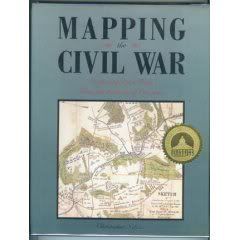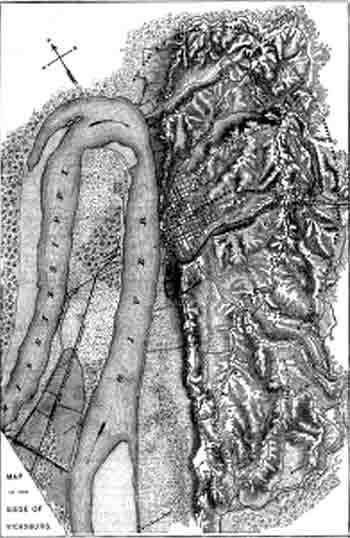
Book Review:
Mapping the Civil War: Featuring Rare Maps from the Library of Congress
Authors: Christopher Nelson, Brian Pohanka, Library of Congress Geography and Map Division
Publisher: Fulcrum Publishing, 1992
This book is part of the Library of Congress Classics series. In addition to reproductions of civil war maps, it has contempory sketches and photos, a good narrative history of the Civil War, and some short but detailed essays on the maps used and mapping during the different campaigns.
The narrative history is excellent for giving the novice student of the civil war an overview of the main course of the war. The pictures give a very realistic feel of what the war was like with out being overpowering.
Of course the maps are the interesting things. There are reproductions of maps from all theaters, levels of organization, uses, and quality. They provide a full panorama of the maps used in the Civil War. It is one thing to know in theory that they did not plan a campaign using EarthGoogle. Instead they had maps that were drawn on a very small scale, had roads and key features missing or not correctly located, to plan the movement of very large forces. That the armies often literally did not know where they were, explains much of confusion of the war especially early in the war.

This is a map of the river in front of Vicksburg MS. (It is the lead map on the in the chapter on the Vicksburg Campaign.) The union gunboats and barges running this stretch of the river under fire from the town bluffs is one of the great sagas of the war. But usually there is not a map or it only shows the river in front of the town not the full hairpin turn. Here you see the tricky navigation that was carried out at night along a course where there could be no surprise.
What I found especially interesting were the excellent large scale maps of fortifications, positions and battles that show considerable skill in producing a map when time and surveying resources were available. Individual units or officers, rather than the Topographic Corp, drew many of these maps. This is a skill that is vanishing since much better can be done with computers and aerial photography.
At the beginning of the war the US was mapped in a rather haphazard manner. Collecting maps, drawing new ones, reproducing, and distributing them was a major challenge for both sides. As the war progressed each side developed a better “data base” of areas in which they operated. Reproduction facilities and efficient distribution methods were set up. When it was decided that an army was going to move from point A to B relevant maps were prepared, reproduced and distributed in a few days and available before the movement began. With its greater industrial capacity the Union did better than the confederacy but the confederacy made significant improvements. The best use was General Sherman’s Atlanta Campaign where one map was developed from the best intelligence that could be had, and every one who needed a map was using the same map. There were actually orders issued like “defend by the letter ‘O' in word 'Mountain'” a sign of high quality maps that had the trust of the users. The topographic staff was part of General Thomas’s Army of the Cumberland, which did most of the logistics work for this campaign.
Maps were prepared by the US Coastal Survey and Army's Topographic Corps, most Topographic Corps' officers stayed with the Union at the beginning of the war. Many volunteer officers who had surveying or drawing skills served on both sides. The best of them was Jedediah Hotchkiss, the principal of a small school before the war, who was Lee’s mapmaker. In the Washington-Richmond theater the Confederates almost always had better maps do to his efforts. When the Union captured his maps the Union reproduced and distributed them. There was an injustice to the officers of the Topographic Crops, they were so valuable in that role they would not be released to command regiments brigades and divisions, with the appropriate promotions that many Regular Army officers in other branches recived. None the less they performed excellently thought out the war.
The only problem with this book is that many of the maps are not reproduced on a scale that allows you to use the actual maps used by the armies to follow the action.
This is an excellent book assessable to all levels, well written with good pictures and maps. I would say that for a person is only going to read one book on the Civil War this is a good candidate. If you are person who likes maps this is a gold mine.

5 comments:
I will have to get a look at this book. I have a beautiful set of maps from the Official Records published in a mass market edition a few years back. I wonder to what degree these works are the same, or different.
You have a good point about Lee's maps, but the Union's got better as the war went on -- they could simply focus bigger resources on the problem. Also, in general, IMHO, the Union had a better staff system, (so many of Lee's failures can be laid at the feet of poor administration and staff work).
El Jefe
Thanks for the comments
If you want to follow a battle I think the West Point Atlases are the best.
The staff system both sides inherited was not what we would call a modern General Staff. It was a reform made after the war of 1812 and depended a lot on the interest and inclination of the commander. It could work well or it could defeat an operation before the enemy had a chance. It is often noted that the best battle leaders went south, but the unstated part of that was the best technicians and administrators went north.
The Army of the Cumberland, which was the biggest Union Army after the Army of the Potomac, often gets short shift because it’s second and third commanders were Buell and Rosecrans and it’s last commander the underrated Thomas. What is missed is they built an army better able to handle logistics over long distances than any other army in the war. Sherman provided the strategic vision for the Georgia campaign but the AOC logistics made it possible. (I doubt Sherman or the leading confererate commanders could have built that organzation, but Sherman knew how to use it.) The Confederates had some first rate commanders in a battle and they won some but they could never get in a position to stop the juggernaut that was rolling at them.
(The AOC's first commander was Sherman who went on medical leave for emotional instabilty.)
And it was a good enough logistical system to support multiple armies, and well supported and organized to protect the Lines O'Communication against anything the Confederates could do in Tennessee to disrupt it once Sherman moved south of Chattnooga.
So who gets the credit for building the system in the West ? McClellan has to get a lot of it in the east, along with Stanton, Halleck and Hermann Haupt, the railroad genius. But who in the west ?
Grant and Halleck get a share, certainly, and Stanton of course, but I wonder if old Rosecrans maybe deserves more praise than he gets ? He had a bad day at Chickamauga, certainly: but prior to that he ran a great campaign, over distances and some real rough terrain: turning Bragg out of Chattanooga very neatly.
I probably know more about the Confed. side of things -- and the mention of Braxton Bragg is apt to make me start foaming at the mouth.
As for never getting in position to stop the juggernaut: I think there were three more or less good chances of hurting the Yankees bad enough, possibly to get foreign recogition or maybe set up a negotiated peace, in the East: once at White Oak Swamp/Glendale, when McClellan, during his retreat to the James, split his army and left a flank open.
At Second Manassas, Lee's greatest victory, he came within an ace of wrecking Pope's whole army -- but Warren held Longstreet off Henry Hill just long enough. The surrender of Harper's Ferry with 10,000 prisoners in Sept. 1862 might have been the straw that broke Abe's back, in terms of getting British French recognition and screwing up the 1862 elections -- had Sharpsburg not immediately followed it.
But that was the best they could do: create political conditions, or caused external events such as foreign recognition or intervention that might, or might not have panned out. The south could never have beaten the north in military terms.
After the 1862 elections, the only prayer the south had was to hold out long enough to wear out the North, and deny Lincoln re-election. Lee held out in Va, but that part of the war was lost in the west to Sherman.
El Jefe
When I sad juggernaut was thinking of Sherman’s campaign. The potential existed in the Virginia theatre but union did not try to do that until Grant saw the possibility. The Uninion had enough second rate generalship in that theate that pulling a victory that could turn in to foreign support was plausible..
In the West there were really two union drives. Overlapping and intertwined but separate.
One to clear the Mississippi- the Armies of the Tennesse and Missippi. Shiloh and Vicksburg were the main battles. I think credit goes to Haleck for the logistics behind that drive. I forget the name but there was a general, who never led anything in combat who is always listed as commanding the union forces in the upper Mississippi. I suspect he kept the stuff moving after Halleck got involved at Corinth and the East.
Second was to capture Chattanooga - the Army of the Cumberland, under different names. Beull got logistics off to a good start though they lost some ground when they were combined under Halleck and in the massive counter marching of 1862. The nine months Rosecrans sat at Murfreesboro he was not really sitting there. He was making reorganizations, weeding out unsuitable officers, and organizing special logistics units, which often retained their infantry designation. Other than being quirky his only fault was trying to fight major engagements like they were Brigade actions. There was just too much to keep straight in his head. At both Murfreesboro (Stone River) and Chickamauga he lost track and almost blew it. In both cases it was George Thomas that pulled him out.
The two forces were combined again to move on Atlanta.
Eggszactly.
You could write a pretty hefty volume covering the tangled organizational history of the Army of the Cumberland and its many names. Gets even weirder trying to keep up with its subordinate units.
Post a Comment